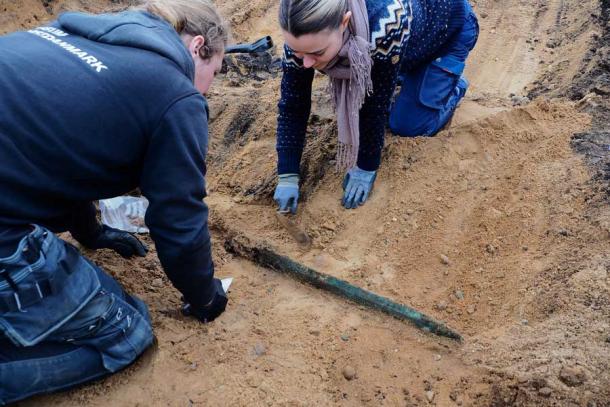A bronze sword has been extracted from the ground in Denmark. Archaeologists are amazed at the excellent condition in which it has been found, including its wood and horn hilt which have survived for around 3000 years.
A ‘Unique’ 3,000-year-old Find
Chief Inspector Jesper Hansen of Odense City Museums has been ‘delighted’ by the find, which he says is ‘unique’ due to the fantastic state of preservation.
“We are dealing with a 3,000-year-old wonder” he comments in a press release on the Odense City Museums website.
The almost completely intact bronze sword was found in excavations at Håre on West Funen, the third largest island of Denmark.
The bronze sword is quite heavy, weighing in at 1.3 kg (2.85lbs), and much of the hilt of the sword is still extant, with remains of wood, horn and tack still attached to the metal. The sword is ornate and is thought to have been buried as part of a ritual or ceremony, as it was found to have been wrapped in a bast material (made of wood or plant fibers such as flax or hemp) before being placed in the ground and buried.

Archaeologists carefully extracting the sword from the excavation site in Håre, Denmark ( Odense City Museums )
Bronze Sword Was Long in the Pipeline
The almost immaculate piece of metal was retrieved during archaeological investigations that were a mandatory part of a gas pipeline development that is to run through the area. Over the last year, the museum has surveyed the whole route of over 60km (37 miles) and the sword find was made on the very last part of the survey.
The weapon has lain dormant in the ground for the best part of three millennia, and it is remarkable that some of the organic material remains.
Bronze was developed at slightly varying times around the world, with the discovery first of the smelting process , for which there is archaeological evidence dating back around 7000 years found in Serbia . This was employed to extract metals such as copper from ore, which was later (around 3500 BC, as far as currently ascertained) was combined with tin to make the stronger and more durable alloy of bronze. This metallurgical discovery was a major leap in technological advancement.
Although the sword displays degrees of technical advancement and skilled craftsmanship, it remains in the era of prehistoric objects, with historical sources for the region only becoming available from the 9 th to 10 th century with Roman historian Tacitus’s Germania, and even later medieval monks writing histories drawn from the oral histories of the Viking era. But the origins of this sword predate all of this by a couple of millennia.

The sword was found in excellent preservation, and a delicate process of conservation has taken place. ( Odense City Museums )
Story of the Sword
The museum has preliminarily dated the sword to Bronze Age period IV, but a metal sample will be analyzed which will help determine the age of the sword and the origin of the metal alloy from which it is made. According to Heritage Daily , at this time, much of the metal used in the area would have been imported from further south in Central Europe and then worked by local metalworkers.
According to the Encyclopedia Britannica around 6000 years ago, agriculture and farming began to develop in the region, and by 2400-1700 BC they entered the ‘Dagger Period’ with finely crafted stone daggers and spearheads being made from stone , which were modelled on imported metal examples.
It wasn’t too long before they had mastered some metalworking techniques and by 1000 BC, they were producing their own weapons of bronze. This indicates some of the cultural and technological exchange that this culture would have been engaged in around the time of this sword’s production.
Examination of the materials used in the production of this sword could help to reveal further the extent of the travel and trading network that existed at this time.
Conservation of the Bronze Sword
Now that the sword has been removed from the earth that protected it for so long, a complicated conservation process is required in order to prevent the onset of rapid deterioration due to air exposure. The museum explains in its release how it has been necessary to separate the different materials of metal, wood, horn and bast for the suitable preservation methods to be applied.
Along with this, samples will be taken for testing to determine the exact origins of the various materials. Radiocarbon dating can also be used to further confirm the age of the sword. These studies will allow as much of the story of the sword as is possible to be revealed, giving an indication of processes and materials that were available in the region.

The object includes metal, wood, horn and bast in its construction. ( Odense City Museums )
When the analysis and conservation work is completed, the conservator will carefully reassemble the sword ready to go on display. The sword will be exhibited at Møntergården, the cultural history museum in Odense.
Top image: Hilt of the Bronze sword with grip materials removed. Source: Odense City Museums
By Gary Manners
Related posts:
Views: 0
 RSS Feed
RSS Feed

















 March 13th, 2021
March 13th, 2021  Awake Goy
Awake Goy  Posted in
Posted in  Tags:
Tags: 
















